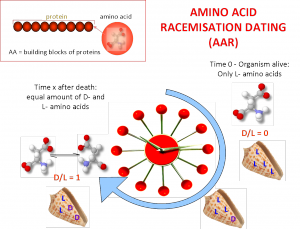There are many types of dating in archaeology, including dendrochronology, radiocarbon, and potassium-argon dating, but most only accurately measure back about 50,000 years. Amino acid dating, also known as amino acid racemization, is a dating technique capable of measuring backwards up to three million years. It works by extracting proteins from a deceased organism and separating them into categories of amino acids. By measuring the exact ratio of two different amino acids, archaeologists can create an estimate of how long ago the specimen died, an example of which can be seen in Figure 1 (Demarchi 2020). Although this dating technique is usually considered relative and most effective when used in comparison with other dated artifacts, it is also capable of being an absolute method.

Figure 1. Fundamentals of amino acid geochronology. Chart by Dr. Beatrice Demarchi. https://www.antarcticglaciers.org/glacial-geology/dating-glacial-sediments-2/amino-acid-racemisation/
Unfortunately, despite its potential, amino acid dating is used more rarely in archaeology than expected. When it was first developed in the 1960s, various environmental aspects caused some fossils to lose their original protein, impacting early studies. After more time was spent studying amino acid dating, more reliable methods were produced, but the previous issues caused it to be pushed aside by many archaeologists.
Luckily, amino acid dating is now becoming slightly more common. For example, University of York researcher, Kirsty Penkman, has been using amino acid racemization to date molluscs, egg shells, and corals, up to three million years old, as can be seen in Figure 2. Penkman is also currently working on a large project involving using amino acid dating to date hundreds of European sites.

Figure 2. Kirsty Penkman works with fossil shells for amino acid dating. Photo from NEaar lab at the University of York. https://www.world-archaeology.com/features/expanding-amino-acid-dating/
Unfortunately, amino acid racemization does present some difficulties. The enclosing matrix is a challenging variable, since it can impact the acids (Method 2016). Temperature is also heavily connected to the accuracy of amino acid dating. Faster reactions occur in the development of the amino acids when it is warmer, so more precise dates are produced. However, these dates go back a shorter period of time. Slower reactions occur when it is cooler, so the dates are less specific, but go back over a longer period of time (Marchini 2020).
Although there can be some inconsistencies, overall, amino acid dating holds a lot of promise. It can provide insights to human behavior, such as the use of fire and burial practices (Johnson, and Miller 2007). It can be used to date a variety of artifacts, including mollusks, ostrich eggshells, corals, and some sediments. Using the amino acid dating on sediments is invaluable when incorporated into stratigraphy. Amino acid racemization can even be used on tooth enamel, allowing archaeologists to date mammals, including human remains. And because it can cover a large period of time, it is incredibly valuable when looking at human, animal, and technological evolution.
Further Readings
Identification of Remanie Fossils Using Amino Acid Racemisation
References
Demarchi, Beatrice. “Amino Acid Racemisation.” AntarcticGlaciers.Org (blog), June 22, 2020. https://www.antarcticglaciers.org/glacial-geology/dating-glacial-sediments-2/amino-acid-racemisation/.
Johnson, B. J., and G. H. Miller. “ARCHAEOLOGICAL APPLICATIONS OF AMINO ACID RACEMIZATION.” Archaeometry 39, no. 2 (September 7, 2007): 265–87. https://doi.org/10.1111/j.1475-4754.1997.tb00806.x.
Marchini, Lucia. “Expanding Amino Acid Dating.” World Archaeology (blog), May 27, 2020. https://www.world-archaeology.com/features/expanding-amino-acid-dating/.
“Method – Amino Acid Geochronology Laboratory – Northern Arizona University,” October 2, 2016. https://web.archive.org/web/20161002171642/http://nau.edu/CEFNS/NatSci/SESES/AAGL/Method/.

What changes to the use of amino acid racemization might make it more useful for archaeological study?
The main change would simply be to increase how often it is used. It is a reliable way to improve chronology and find thermal histories, but is rarely put to use. Past errors turned many archaeologists away from the technique, so taking advantage of it could prove very beneficial.